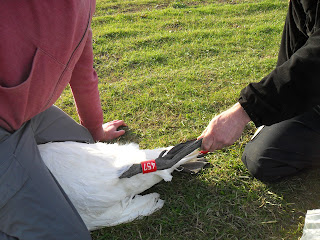Dan joined us again for another day of hoped for experience of larger birds and ring sizes, having ventured and helped out previously in the freezing conditions during February. It was certainly milder today and things started well with 1 new and 5 re-trap Shelduck at Thorganby along with 3 new Mallard and a trap full of re-traps - 4 G rings nicely fitted and good ageing and sexing (and processing) experience. Female Mallards can tend to be quite difficult to age and so some were recorded as a '4', Similar to the males, females should have broad black tips to the greater coverts, however the tertials are often very variable and perhaps more unreliable than previously thought.
Ageing female Mallards
Shelduck - a new bird for Dan
This Shelduck was aged as a '7' by the white tips to the primaries, and noted as a female due to the lack of a knob and presence of a diffuse grey nail on the tip of the bill.
The next trap brought another new Mallard and Shelduck to ring, so another 2 G rings fitted and once again another box full of birds to be processed. There was a good mix of adult and juvenile birds which gave good comparisons, the adult male Mallards (below) were aged by looking for sharp tertials (broad and long, also more greyish than juveniles), and broad black tips to the greater coverts.
Craig explaining how to age a male Mallard
Shelduck ringing on the pool
A visit to North Duffield Carrs brought only a single drake re-trap Wigeon in the trap there, but two un-ringed non-territorial Mute Swans in the whoosh net on the river bank were swifty taken - big birds delivered for a big bird experience! Another new bird for Dan & good experience to try & work out how to fit the 'eagle specials'! The cob was also fitted with our last darvic - 457. Currently there are two pairs of Mutes nest building at North Duffield, one at Bank Island and four at Wheldrake, hopefully they'll do well again and between them produce many cygnets.
Mute Swan '457'
We then checked the nest boxes around North Duffield Carrs, a pair of Barn Owls were present in both boxes, very pleasing to see, lets hope they have a successful breeding year & produce many chicks! We then zipped over the road to North Duffield Ings and added a nice adult Tawny Owl that was roosting in the box to the list of todays G rings (Dan soon got used to the technique of fitting these - & it was abit of a breeze after handling the Mutes!). We also got abit of a surprise after netting the Tawny, to find a Grey Squirrel which had been pinned in at the back of the box! It was probably relieved and made a quick get away! The Tawny Owl was sexed as a female by the presence of a brood patch, and aged as an adult due to atleast three generations of wing feathers.
Adult female Tawny Owl
There's a great deal to gain from ringing at other sites and with other groups, and it's great for us to be able to share it and what we do with others, so all in all, an enjoyable day, with 2 Shelduck, 4 Mallard, 2 Mute Swans and a Tawny Owl ringed (all new species for Dan), with another 22 Mallard and 6 Shelduck re-traps processed. There was added interest with an Osprey north over the River Derwent at North Duffield Carrs during the afternoon, plus a Wheatear on the floodbank - time to get the mealworms ready!









No comments:
Post a Comment